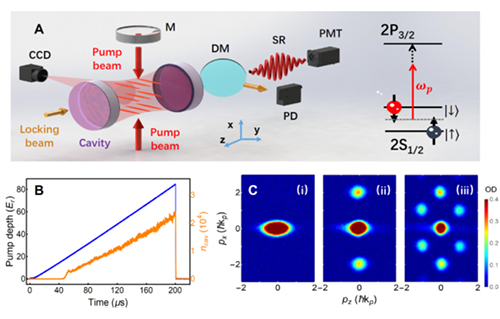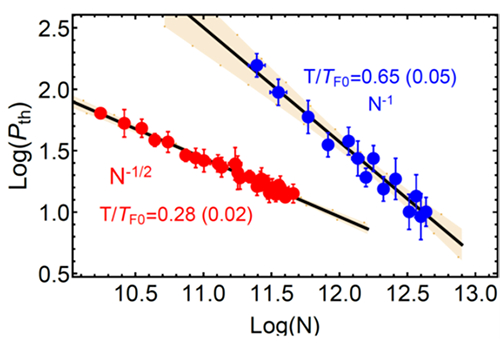Funded by the National Natural Science Foundation of China (Nos: 11925401, 11734008), WU Haibin’s research team from the State Key Laboratory of Precision Spectroscopy of East China Normal University as well as associate professor CHEN Yu, the Graduate School of the China Academy of Engineering Physics made progress on realizing the steady-state superradiant quantum phase transition (QPT) in the ultracold Fermi gases for the first time and observing the influence of Fermi statistics on phase transition. The result is published in Science as “First Release” on August 26, 2021, titled as “Observation of a superradiant quantum phase transition in an intracavity degenerate Fermi gas”. The link of the paper is http://www.science.org/doi/epdf/10.1126/science.abd4385.
The combination of ultracold quantum gases and cavity quantum electrodynamics (cavity-QED) provides an ideal system for studying the novel QPT. The well-known Dicke model describes the cooperative interaction between light and atoms, which predicted a second-order QPT from normal to superradiant phase occurs under the strong coupling regime. Since proposed in 1973, the Dicke phase transition has not been realized until 2010 by using the momentum states of a Bose Einstein condensate. Fermion, in contrast to bosons, obeys the Fermi-Dirac statistics. Coupling fermion with cavity-QED has attracted wide attention for a long time, but experimental research is extremely challenging. Whether it is possible to achieve matter wave amplification in Fermi atoms has been debated since 20 years ago. Although the QPT was predicted theoretically in 2014, in which quantum statistics and lattice nesting play an important role in the steady-state superradiant QPT of Fermi gas, fermi statistic in such QPT has not been observed experimentally.
The research team, led by Prof. WU Haibin and Associate Prof. CHEN Yu, focuses on this challenging topic, observes the steady-state superradiant QPT in fermions for the first time and reveals the fermionic statistics’ influence on QPT in fermionic 6Li atoms by achieving the strong coupling between Fermi gases and optical cavity and developing the methods of precisely manipulate the optical resonator’s frequency and temperature of ultracold Fermi gases. Using a laser whose frequency is smaller than atomic resonant frequency to transversely pump the Fermi gases inside an optical cavity, when the pump intensity is lower than the QPT threshold, the gain of scattering light is smaller than the dissipation, the cavity has no transmission light and fermionic atoms show a typical momentum distribution as expected in shallow lattice. Once the pump intensity above the threshold, an emergent light field builds up inside cavity and interferences with pump field to consist a 2D optical lattice. Atomic fluctuations induce the superradiant QPT, in which the fermions self-organized into checkerboard pattern, as shown in Fig. 1.
Due to the Pauli exclusion principle, the probability of scattering pump light varied. The scaling of QPT threshold on atom number depends on the Fermi energy, which shows a difference from bosons and hot atomic gases. In the high temperature, the scaling between threshold and atom number (N) is N-1. In the low temperature, the scaling becomes N-1/2, as shown in Fig. 2.
This work provides an ideal platform for studying the nonequilibrium dynamics in fermionic system with long range interaction, will open many new research directions and pave the way to realizing a plethora of proposals for quantum simulations that would harness photon-mediated interactions to explore many-body physics of long-range-interacting fermions.

Fig. 1. Fermionic steady-state superradiant quantum phase transition.

Fig. 2. The scaling of threshold on atom number in steady-state superradiant QPT.

Add: 83 Shuangqing Rd., Haidian District, Beijing, China
Postcode: 100085
Tel: 86-10-62327001
Fax: 86-10-62327004
E-mail: bic@donnasnhdiary.org
京ICP备05002826号 文保网安备1101080035号 Copyright 2017 NSFC, All Right Reserved